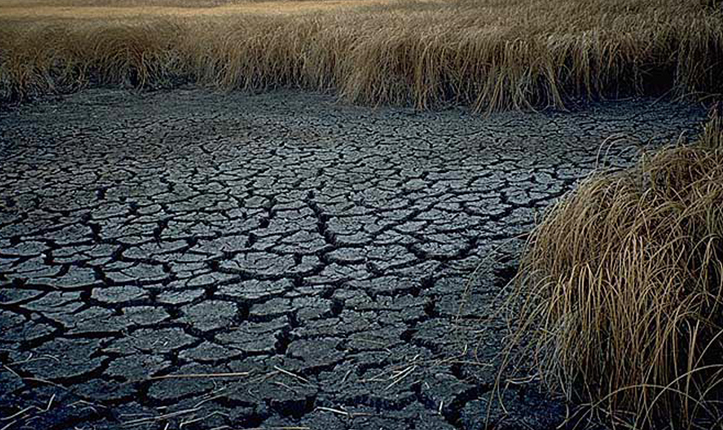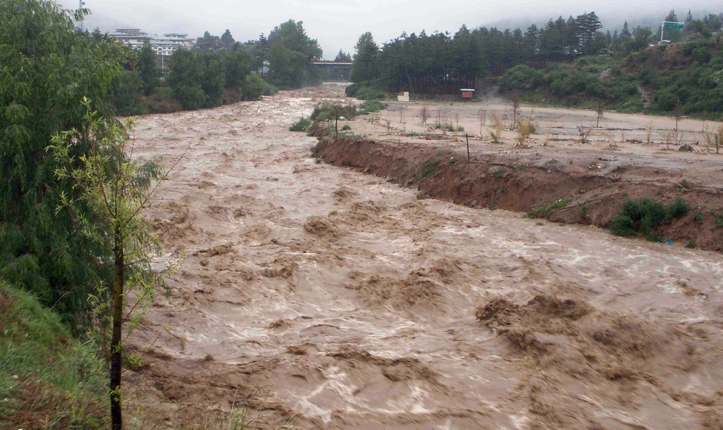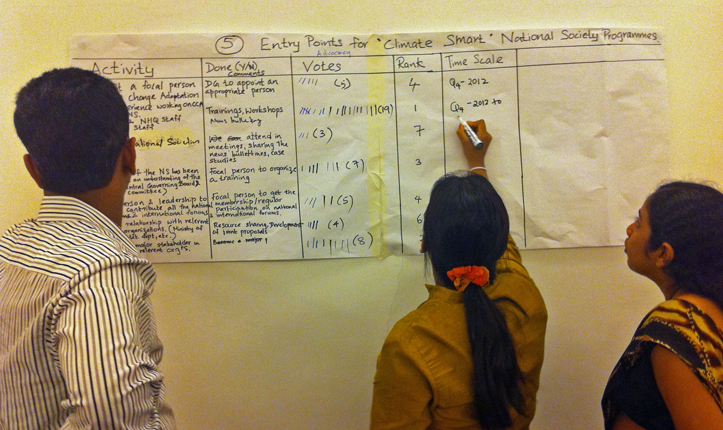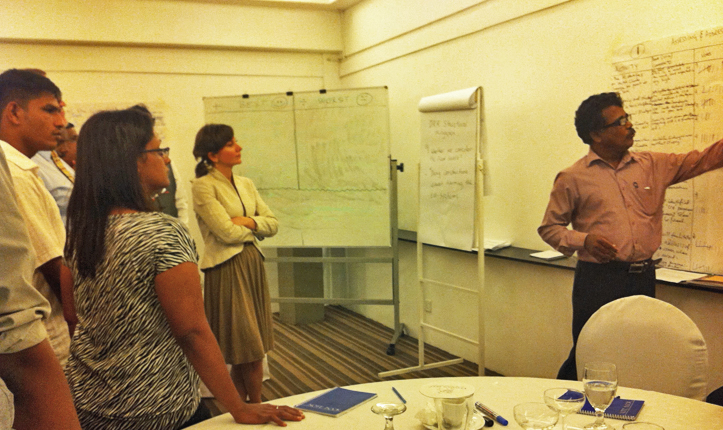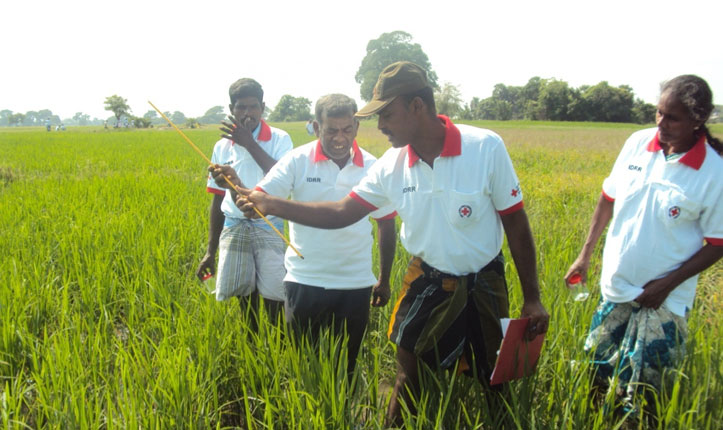“Adaptation” – a practical approach towards climate change
By Mahieash Johnney – IFRC Communications & Information Manager in Sri Lanka / Video by Zafran Packeerally – IFRC Communications Officer.
01/09/2012 – Colombo, Sri Lanka: Climate Change, is a subject rarely discussed in countries like Sri Lanka, however the affects of the subject is now visible and felt by many in this paradise island. Simultaneous floods and droughts, slow and continuous rise of ambient temperature, high variability of rainfall, tornado type winds, lightning, cyclones, sea level rise are some of the issues now seeping into daily news reports and conversations among the masses.
The subject of climate change began to pop up with the tsunami in 2004. The discussion mainly rotated around adverse change of environment. Steps were immediately taken by the Government to set up relevant bodies to look into such environmental changes and how it could impact life in the island. The Meteorological Department of Sri Lanka was appointed to be the coordinating body for environmental changes. A Climate Change Secretariat was also set up in order to deal with policy level matters.
Even though the implementation of these bodies has not resulted in reaching the level of success in finding practical approach to the changes occurring in daily lives of people. Sri Lanka nation is heavily depended on agriculture, hydropower, and forestry, which are direct areas that will take a direct, hit by the changes related climate change.
What is Climate change?
Climate change may be due to natural internal processes or external forcing or to persistent anthropogenic changes in the composition of the atmosphere or in land use (IPCC, 2001).
Since the industrial revolution, change of climate has been occurring at an accelerated rate as a result of human activities such as fossil fuel burnings, change of land use practices (in particular deforestation), emission of industrial gases etc. The global warming of the earth-atmosphere system is brought about by enhanced greenhouse effect.
Greenhouse effect makes the surface of the earth some 33 C warmer than it would otherwise be (i.e. with a mean surface temperature of 14 C instead of –19 C) and allows life forms to exist. The gases that are responsible for this enhanced greenhouse effect in the natural atmosphere are Water vapor (H2O), Carbon Dioxide (CO2), Nitrous Oxide (N2O), Methane (CH4), Ozone (O3), Hydrofluorocarbons (HFCs), Sulphur Hexafluoride (SF6) and Perfluorocarbons (PFCs).
Atmospheric concentration of CO2 has rapidly been increased from 280 ppm during the pre industrial era to 365 ppm at present, due to enhanced anthropogenic activities to make human lives more comfort.
Sri Lanka on the climate change map
Being a developing island nation subject to tropical climate patterns. Any adverse changes in already volatile weather patterns are likely impact adversely on the socio-economic activities in the country.
The country has experienced a change in rain patterns, temperature rise and a surge of sea level.
Annual average of rainfall over Sri Lanka has been decreased by an amount of 144 millimetres, about seven percent, during 1961 to 1990 period compared to 1931 to 1960 period* with the standard deviation increasing from 234 to 263 millimetres. Northeast monsoon rainfall over Sri Lanka has been decreased from 1931 – 1960 to 1961-1990 periods, with an increased variability. High variability of rainfall patterns could probably be due to global climate change with the increase of Greenhouse gases in the atmosphere.
Meanwhile annual mean air temperature anomalies have shown significant increasing trends during the recent few decades in Sri Lanka. The rate of increase of mean air temperature for the 1961-1990 period is in the order of 0.016 0C per year. Annual mean maximum air temperatures have shown increasing trends in almost all stations with the maximum rate of increase about 0.021 C per year at Puttalam.
These vulnerabilities cut across many sectors in the economy, and threaten to compromise the significant achievements the country has recorded in the last 20 years in increasing incomes and reducing poverty, as well as our ongoing development drive.
Living and coping with uncertain impacts of climate change is no longer a choice; it is an imperative. Sri Lanka needs to address climate change adaptation to ensure that its economic development can continue without disruption or setbacks, and investments in poverty reduction, food and water security and public health will not be undone.
Red Cross action
With the changes that is been experienced in the environment the Sri Lanka Red Cross Society (SLRCS) with the support from the International Federation of Red Cross & Red Crescent Societies (IFRC) has understood the importance of investing more on climate change related issues. The organizations are now looking at how they can fine-tune the existing programming in order to accommodate issues that may arise due to climate change.
A workshop was organized recently under the theme “Capacity building on climate change adaptation” jointly by SLRCS & IFRC with the support from the IFRC Climate Change Centre in the Netherlands.
Knud Falk, Technical Advisor of the Climate Change Centre was the facilitator of the workshop. We asked him as to why it is important for a country like Sri Lanka to keep forging ahead in finding homegrown solutions for climate change.
Meanwhile the German Red Cross in collaboration with SLRCS has begun to aid areas that are most vulnerable to climate change especially in the eastern part of the country. Paddy farmers in selected communities in Uhana, Ampara are being trained on safe cultivation practice, which is designed to face effects of climate change.
However the question rises as to why a humanitarian organization like the Red Cross should in anyway engage in climate change related issues.
In terms of finding solutions for climate change means simple changes to existing workplan. Falk is of the view that any forthcoming orgniazation programmes should be geared to be climate smart.
- Chandrapala Study
- Data Source from the Climate Change Centre of
